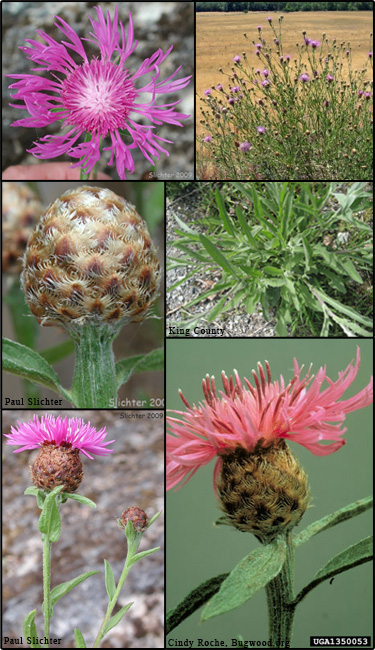Meadow knapweed (Centaurea xmoncktonii)
 Description: Fertile hybrid between black and brown knapweeds.
Description: Fertile hybrid between black and brown knapweeds. Habit: Biennial; deep-rooted perennial; growing each year from a woody root crown.
Leaves: Basal leaves are up to 6 in (15.2 cm) long, tapering at both ends and having the broadest part above the middle of the leaf, stem leaves are lance-shaped, shallowly-lobed, and stalkless.
Stems: Few to several stems with many branches; mature plants reach 3.5 ft (1.04 m) tall.
Flowers: Rose-purple in color, although white flowers occasionally occur; heads are solitary at the ends of the upper branches, broadly oval and almost globe-shaped, 0.5 in (1.3 cm) long with a fringed margin.
Fruit and seeds: Seeds are pale tan in color, plumeless, 1/8 in (2 cm) long.
Habitat: Native to Europe. Grows well in moist soils and found in disturbed sites, roadsides, fields, open grassland, pastures, and forest edge at low- to mid-elevations.
Reproduction: By seed.
Similar species: Spotted knapweed (Centaurea stoebe), which can be easily distinguished by its leaf shape and color. Spotted knapweed leaves are grey-green and more deeply lobed.
Monitoring and rapid response: Hand-pulling; effectively controlled using any of several readily available general use herbicides. Credits: The information provided in this factsheet was gathered from the Bugwood.org wiki, the Central Kootenay Invasive Plant Committee and the USDA PLANTS Database.
Individual species images that appear with a number in a black box are courtesy of the Bugwood.org network (http://www.invasive.org).Individual photo author credits may not be included due to the small display size of the images and subsequent difficulty of reading the provided text. All other images appear courtesy of Google (http://images.google.com).
Common Name: | Meadow knapweed |
Scientific Name: | Centaurea xmoncktonii |
Family: | Asteraceae (Aster) |
Duration: | Perennial |
Habit: | Herbs |
USDA Symbol: | CEMO6 |
